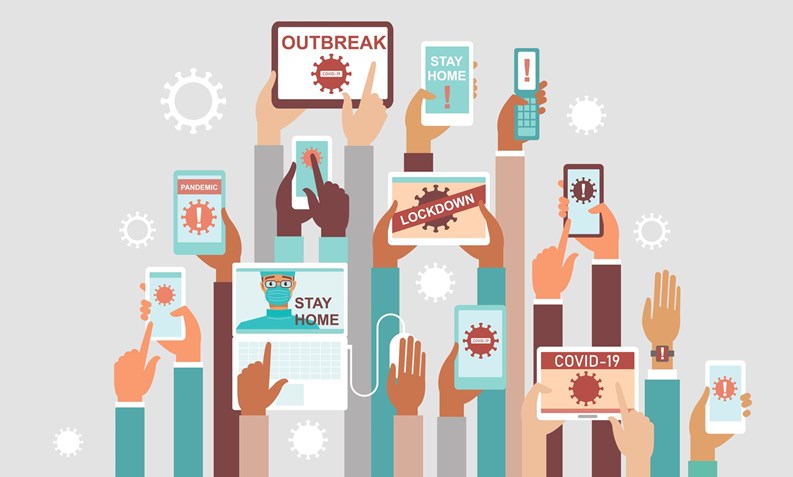It’s become axiomatic that over time, technology gets smaller, more efficient, and more capable of multiple increasingly sophisticated and specialized tasks. Think about your mobile phone. There was a time in the not-so-distant past that its predecessor, the car phone, was tethered to the inside of your vehicle, and its sole task was to make voice telephone calls. Now consider your current smartphone. It’s everything from a multi-option means of communication to a pocket-size encyclopedia, placing pretty much the whole of accumulated human knowledge in the palm of your hand.
Technologies developed for use in the real estate industry have gotten smaller, more efficient, and more multifaceted with each successive generation, too. And now with the coronavirus being a looming presence over nearly every aspect of multifamily life, developing technology may also offer tremendous unexpected benefits to mitigate COVID’s unexpected consequences.
The Intersection of COVID & Tech
When developers—both real estate and software—initially devised technologies as refinements for residential buildings and their occupants, chances are they weren’t anticipating that those innovations would one day be used to combat and control a public health crisis like COVID; emergencies like fires and power interruptions, sure. Keeping residents and their property safe from intruders and other threats, certainly. But a highly infectious, potentially deadly microbe sweeping the globe and bringing the business of everyday life to a crawl, or even a grinding halt? Not so much.
Zachary Kestenbaum is the CEO of BuildingLink, a national provider of multifamily building technology located in New York. “We know that in property management, being prepared for the unexpected and establishing clear and proactive communication is essential, and that’s been especially true during this pandemic. Communities that came into the pandemic with electronic systems already in place and having already switched their administrative processes over to digital and automated methods were able to adapt as rapidly as the facts on the ground did.”
This was especially helpful during the depths of the first wave back in the spring, says Kestenbaum. “Think of a property manager who may be quarantined off-site,” he says. “Instead of flying blind, they can log in, see everything that’s going on at their client buildings, leave instructions for staff, review photos and service notes of a broken fixture—that is really empowering.”
“Technology for security and access control systems, video intercoms, online payments, package tracking, communication tools, and virtual tours platforms already exist and are under refinement,” says Neil Golub, director of sales for Carson, another provider of tech services for residential properties. “With COVID, property managers, staff, and residents need to operate remotely more than ever before. With staff not in office, the Cloud has become even more important for its ability to make working online more efficient, and remote operations are essential—especially for digital payments. We’re seeing expedited adoption of these services now. Also, anything related to cleanliness is a plus.”
“When we think about steps that everyone needs to take during the pandemic,” says Larry Link, a real estate developer in New Haven, Connecticut, “we think about social distancing, masks, limited gatherings, etc. With this in mind, one thing that the technology we integrated into our building systems includes is access through key fobs or cards, providing residents with access to the property both cleanly and remotely. [Electronically enabled] keys can be issued to any pre-screened person who can then come to the property and gain one-time temporary access—for apartment cleaning or package delivery, for instance. However, I wouldn’t limit this tech solution to just something that aided us during the pandemic; it’s something that makes management easier overall, pandemic or not.”
And, adds Marcy Kravit, COO of Broken Sound Master Association in Boca Raton, Florida, “the coronavirus pandemic has posed serious issues for condominium life. As a result of the crisis, managers have been forced to shift gears in the way they are handling certain tasks and operations—and technology has played an important role in delivering the same level of services as were provided in person before the pandemic began. E-communications via various apps ranging from conventional email to phone-based notification systems and text messaging are critical for announcements, especially when implementing and explaining an association’s COVID policies and procedures.”
How Does It Work?
Golub says his company has seen a steady increase in users even before the pandemic began, especially with the rise in e-commerce in recent years. However, in the six months since the beginning of the coronavirus crisis, from April through September, he says they’ve seen a 55.6% increase in deliveries per resident, most of which have been handled by Carson’s 24/7 Remote Doorman services. Remote Doorman enlists live remote operators who buzz couriers and other delivery people into the building. They verify who they are by camera and code and buzz them in. The delivery people leave the package in a designated locked area or a cage. “We get them into the building without interrupting the resident, which is important now that so many people are working from home and can’t be interrupted,” says Golub. “We instantly notify the resident that a package is there by whatever their preferred means of communication is.” That could be email, text, or a phone call.
“Digital signage, permanent screens with alternating messages, are also becoming increasingly popular in common spaces in many Florida communities,” says Kravit. “For instance, digital signage units are an excellent option in mail rooms for communicating with unit owners. Also, banks are offering online lockbox services for both unit owners and community managers, and many have integrated with accounts payable software programs that make it easy for board members to sign checks and get their vendors paid.”
Link concurs with Golub on the benefits of remote access technology. “We actually haven’t had a very big impact on management from COVID,” he says, “but having this technology has helped with getting vendors into the building, which we would need in any event. Its benefits are not COVID exclusive though.” It’s a net positive to be able to get someone like a cleaning service employee into the building or unit with remote access. You never have to be home. Limited key entry can be offered to anyone, and it is tracked via timestamping. “We also have video evidence for confirmation and control,” Link continues. “The package room is fitted with remote notification to recipients, too. Our system also tracks use of the gym and common areas as well. If there are too many people in the space, we can manage it. Limiting in-person contact with all these video-based and other controls is very valuable in battling COVID.”
Accelerating Adoption
Golub stresses that COVID has expedited the adoption of technology, both at the building level, and the user level. “We’re seeing more and more buildings upgrade during this time,” he says, “especially buildings that may have security issues or a malfunctioning intercom. For example, in the six months from April through September, we’ve seen a 108% increase in resident door openings via the Carson app. New inquiries are up and steadily growing. There are more in the security space requesting software, such as access control and intercom apps. Ours is a stand-alone app, and Carson is pretty much a software delivery company. In terms of security, if there’s no doorman, how are people getting in? Duplicate keys are a good example. We are seeing buildings phase these out and provide access through the Carson app directly through their phone to let you in. Your phone becomes a key.”
“We’ve developed solutions to increase residents’ safety and convenience, and to help managers adapt to new requirements,” says Kestenbaum. “Residents can now pick up a package without touching a signature pad at the front desk, using the resident mobile app’s new Contactless Package Pickup. We’ve built touchless access control into the app for residents, so they can gain entry without needing a key or fob. We helped buildings address their need to screen and track visitors and contractors entering the premises with brand new COVID screening forms. We’ve also just released a new Inspections feature, helping properties establish protocols around property-wide inspections and routine cleaning of common areas.”
Kravit adds, “Many condominiums have installed touchless countertop or kiosk temperature scanners in their lobbies to protect their residents. High-potency air filtration systems that include germ-killing UV lights and the MERV-15 grade/HEPA air filters used in hospitals to purify spaces and attack germs are being considered, especially in fitness centers. Many associations are also using apps to communicate with their owners and announce guest arrivals and deliveries.”
What’s on the Horizon?
“For multifamily properties,” says Golub, “we’re seeing an increase in the adoption of Cloud-based technologies, giving managers and residents the ability to operate remotely. While security and visitor communication products have become essential, I haven’t seen temperature and thermal devices take off in the multifamily segment yet. Office buildings have been adopting touchless systems and dispatched elevators, and there may be a need for this in high-rise [residential] buildings going forward. Facial recognition is probably too expensive for residential communities, and may be overkill anyway, but security and visitation products like CCTV, ways to secure property though key fobs and cards, also intercom products that work with smartphones—these continue to be the most sought-after technologies and will continue to evolve, becoming more and more sophisticated.”
Link points out that a lot of what happens in the future when it comes to the increasing use of technology depends on who is using it. He maintains that residents are more sophisticated today and have a higher level of expectation for the technology they use than the typical co-op or condo dweller of even a decade or two ago. Access control for their front door without a doorman, for instance, has become almost de rigueur in many newer buildings, as has fob or card access to apartment and amenity space doors. Dedicated, integrated security systems, data and cable, and wifi access are all becoming standard issue, even in small buildings. Luxury isn’t limited to full-service buildings with extensive—and expensive—staffs; small can be luxury, too, if you can check all the boxes. Link strongly recommends ‘future-proofing’ your building by assessing both your current needs and future aspirations, and investing in the tech infrastructure to support them.
While the technological revolution was changing the way we lived as apartment dwellers before the COVID pandemic started, the arrival of the virus has both doubled-down on efforts to use technology to provide security, cleanliness, and ease for residents and emerged as a practical method to battle the silent enemy. Necessity has been the mother of invention. Providers have been quick to apply technology to the challenges of the pandemic and are integrating their technology to seek needed solutions. And boards and managers are getting on board; as Kravit says, whether or not there’s a global crisis on, “it’s our job to maintain the property and provide a positive environment for our residents.”
A J Sidransky is a staff writer/reporter for The Cooperator, and a published novelist.










Leave a Comment